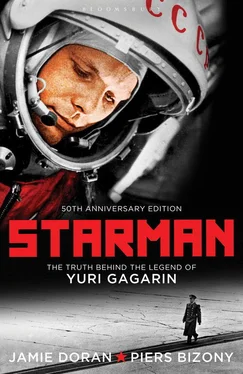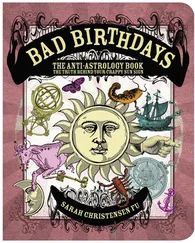Another terrible irony: the catastrophic R-16 missile explosion at Baikonur on October 24, 1960, which killed 190 people, may have precipitated the Cuban Missile Crisis. Quite apart from the vainglorious Marshal Nedelin, a significant number of skilled military missile engineers died that day, and the development of a credible intercontinental Soviet nuclear-strike capability was severely delayed by their loss. For the time being, US strategic targets could not be reached from within the Soviet Union. The one fully functioning ICBM available to Khrushchev was the Chief Designer’s R-7, which took too long to prepare for launch and was not available in sufficient numbers to pose much of a threat. The missiles despatched to Cuba were simpler and less powerful battlefield nuclear weapons: small, numerous, easy to launch, but capable only of short flights.
Once the Cuban crisis was over, Khrushchev may have thought it better to carry on playing harmless space games with the Americans rather than risk all-out nuclear confrontation on the ground. As far as can be judged, the next orbital propaganda coup seems mainly to have been his idea. He wanted Korolev to launch the kind of person no one had thought of before: a woman.
By 1962, up to 400 women candidates had been screened for a possible space flight. On February 16, five were selected for training. In keeping with Khrushchev’s orders, the women were chosen from the ranks of peasants and factory workers, rather than from specialist scientific or academic professions. The most suitable candidates were those who could combine humble origins with at least some kind of suitability for space flight. It just so happened that parachuting was becoming a popular hobby for many ordinary women in those days. The most favoured candidate to emerge for space training was Valentina Tereshkova, a 25-year-old parachuting champion with fifty-eight jumps to her credit. Tereshkova’s father, a tractor driver on a collective farm, was killed in action during the war. Her mother became a weaver in a textile plant, and Valentina herself learned a similar trade. She was ideal for Khrushchev’s purposes: fit, handsome, sufficiently smart for the intellectual challenges of space training, but not so advanced in her education that she could not safely represent the ordinary peasant and working classes. [9] Hooper, The Soviet Cosmonaut Team , Vol. II, pp. 296–9.
Gherman Titov remembers how the female cosmonauts were greeted with distrust when they arrived at Star City. ‘Frankly speaking, we didn’t believe that womenfolk belonged anywhere near a flying machine. At that time, we thought that only men could carry out all the tasks involved in space flight. When the first women arrived, my feelings were negative. As everyone knows, Titov states his opinions on everything! But in the end we saw it was quite correct to have female cosmonauts, and we soon thought of them as good fellows, just like us.’
At last Yuri Gagarin was reassigned to a meaningful work schedule. At Star City he was appointed to head the female cosmonauts’ training programme, in conjunction with his cosmonaut colleague and friend Andrian Nikolayev. On July 12, 1962 he was promoted to Lieutenant-Colonel, and eased his way back into the rhythm of real work by serving as prime radio communicator (what NASA would call a ‘CapCom’) during Nikolayev and Popov’s double Vostok flight in August. Then he laid down an intensive physical training regime for his five female students (though he was still called away at intervals for yet more foreign trips).
By now, the training for a fully automated Vostok mission was not particularly difficult. Tereshkova’s eventual flight on June 16, 1963 presented very few fresh technical challenges. She made a close approach to another Vostok carrying Valery Bykovsky, but, as with the previous double-flight, the real trick was in the timing of the respective launches. However, her success gave Khrushchev the opportunity he was waiting for – to gloat about ‘the equality of men and women in our country’. Once this propagandist experiment was successfully completed, the women’s cosmonaut squad was quietly disbanded. On November 3, 1963 Tereshkova and Nikolayev were married in Moscow in a very public ceremony. It was the social event of the season, much enjoyed by Khrushchev. Three days later Gagarin was promoted to full Colonel. It seemed as if his career was progressing, but, as he would discover, higher rank could hinder as well as help him in his quest for another flight into space.
Bykovsky and Tereshkova’s double-flight was the last mission for Vostok in its current configuration. By the summer of 1963 there was no longer any need for the Soviets to compete with America’s Mercury. After launching Gordon Cooper for a 34-hour mission on May 15, 1963, NASA decided that the programme had nothing else to prove. What more could these simple one-man capsules possibly accomplish?
In fact, NASA was planning to use a new missile, the ‘Titan’, developed by the US Air Force and reluctantly hired out on licence. Titan’s fuel tank and outer skin were one and the same component, which saved weight. On the launch pad, the rocket was so flimsy that it could only stand upright if it was pressurized with inert gas, but it was so powerful in relation to its weight that it could carry a payload much heavier than the Mercury capsule.
NASA knew that its three-man Apollo moonship and its huge Saturn V rocket were years away from a first flight. So far they had only designers’ mock-ups, not real hardware, to play with. Meanwhile, an interim vehicle was developed: a cross between the simplicity of Mercury and the complexity of the emerging Apollo. ‘Gemini’ was a two-man capsule designed to mate with the Titan missile. It incorporated ejection seats and hatches that could be opened in orbit to allow for spacewalks. The design was familiar to Korolev from NASA’s open literature.
By 1963 the Gemini capsules were under construction at the McDonnell Douglas plant in California, but none of them had actually flown yet. Korolev was anxious to start work on a successor to Vostok, a larger capsule to match or even surpass NASA’s new design. If he could launch what appeared to be a multi-man craft before the first Gemini was launched, then he would gain political support for building a genuinely more powerful competitor. Certainly Khrushchev wanted him to conjure up a three-man mission as soon as possible, to trump Gemini and embarrass the Apollo effort, although the extent to which he supported the taking of risks with cosmonauts’ lives to achieve this goal cannot be judged today. Khrushchev is often blamed for pushing Korolev into hazardous decisions, but he could not possibly have decided all the technical details. He must have trusted the Chief Designer’s judgement as to whether or not a particular space project was safe.
Korolev took a risk. He decided to adapt the current Vostok hardware to carry two cosmonauts in the same ball – and even three, if they gave up their spacesuits. This new seating arrangement was purely cosmetic; it did not make the Vostok any better, just more cramped and significantly more dangerous. The bulky ejection seats had to be sacrificed in order to make room for the extra men, and if anything went wrong on the launch pad, there was no chance of escape. The new scheme was called ‘Voskhod’ (‘Sunrise’).
Despite its dangers, Voskhod would eventually prove capable of maintaining the Soviet lead, thereby adding impetus to Apollo, and also to Korolev’s ambitious plans for his own moon shot. Vasily Mishin, his eventual successor at OKB-1, insists that the Chief Designer made a man-to-man deal with Khrushchev. Korolev would develop a multi-crew programme at very short notice in return for Khrushchev’s approval for a giant new rocket, the N-1, a superbooster almost the equivalent of NASA’s Saturn V.
Читать дальше












